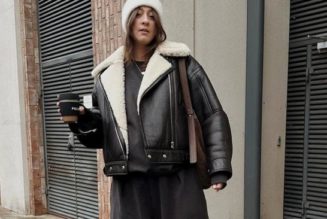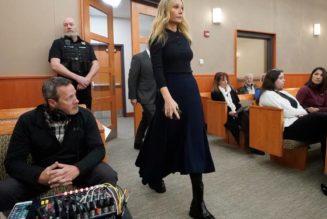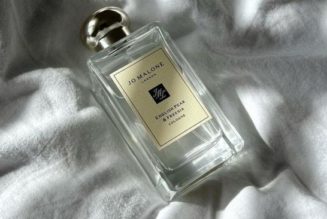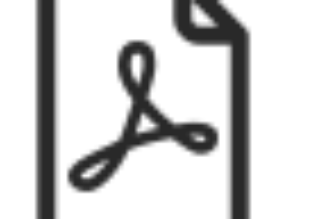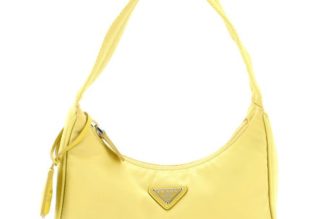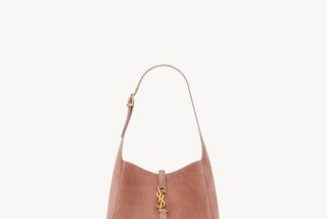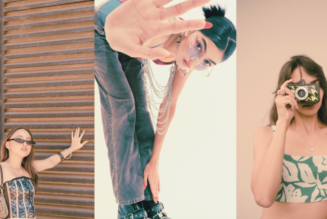Offered any fabric in the world to make their next collection, plenty of designers would opt for vicuña, baby cashmere, mulberry silk, Japanese denim or some such.
Not Iris van Herpen. Her dream would be to use invisibility cloak — except only the U.S. Army seems to have authorization for this mysterious material, which bends the light around an object to make it seemingly disappear.
“It was supposed to come on the market but it hasn’t yet, so,” she laments. “I think a lot of my work is about a hypnotic sense — an illusion.”
Recently the Dutch couturier has been experimenting with 4D printing techniques, based on the same principle as the 3D printing she’s been exploring since 2009.
“But you can build in transformations over time. And you can select what you want it to activate. For example, it can transform shape when heat is involved, or light or movement. So it’s a very beautiful technique. But it is not yet at the stage where I have enough control on the technique in order to really make it my own.”
Uncompromising with the exacting craft she employs to create her mesmerizing, otherworldly couture, van Herpen can make as many as 10 prototypes of each of her creations to perfect the technique and refine the execution. She often uses half-scale dresses first, and then the final, full-size garment “has to be done perfectly.”
A pioneer in employing 3D printing for clothing and footwear, van Herpen is also adept at silicon molding, laser-cutting and water-jet cutting alongside more traditional couture techniques such as hand-pleating, draping and embroidery.
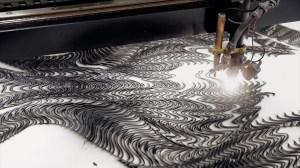
The “Between the Lines” dress was laser-cut from 3mm-thick black leather in parametric wave patterns.
Courtesy of Iris van Herpen
All of these painstaking techniques are on display at the Musée des Arts Décoratifs in Paris, where a retrospective of van Herpen’s work — on until April 28 — is bound to further raise her profile and educate the public about one of the most uncompromising and inventive fashion practitioners on the couture stage.
To be sure, van Herpen’s arresting designs — which draw inspiration from nature, art, architecture and cutting-edge scientific ideas — caught the attention of design experts early, with Holland’s Groninger Museum mounting the first large-scale exhibition of her fashions in 2012, only five years into her career. (The showcase would later travel across North and South America.)
After graduating from the ArtEZ University of the Arts in Arnhem, Netherlands, in 2006, van Herpen interned at Alexander McQueen in London and also with Dutch textile designer and artist Claudy Jongstra before launching her couture brand at Amsterdam Fashion Week in 2007. Her debut collection, titled “Chemical Crows,” introduced her penchant for unusual materials and sculptural shapes: She used the metal ribs of umbrellas to create jutting, samurai-like forms.
She notes that her early work often focused on protective, armor-like constructions to portray an empowering femininity, whereas more recent collections have been “much softer and more focused on the sensitivity and the sensory experience of femininity,” she muses.
Indeed, an impossible lightness defines much of van Herpen’s most recent work, though her dresses are far more hard-wearing than one might think.
“We’ve been able to perfect some of the craftsmanship through those extreme challenges of the skydiving, for example,” she says.
She is alluding to one of her astonishing filmed collections during the coronavirus pandemic. For her fall 2021 couture collection, elite skydiver Domitille Kiger plunged headfirst toward Earth in a heavily embroidered gown that stretched and twitched traveling at 300 kilometers an hour.
“There are very fragile pieces in the archive,” says van Herpen, who wisely kept an “artist copy” of each of her couture creations to date. “But as movement and transformation is such an important element, and given my background in dance.…I want them to be able to handle a lot.” (Van Herpen studied classical ballet before switching to fashion.)
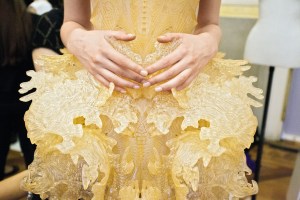
A look from Iris van Herpen’s “Hybrid Holism” collection.
Courtesy of Iris van Herpen/Morgan O’Donovan
In a wide-ranging interview in Paris, where she had her final meetings with the curators of the “Iris van Herpen: Sculpting the Senses” exhibition, the designer speaks about her creative process, her clients and her fierce independent streak.
There was never a question that her focus in fashion would be haute couture.
“It’s where my heart is. I really see fashion as a form of art and with couture, I’m really able to express that,” she says.
Van Herpen dabbled in ready-to-wear from 2013 to 2014 — around the time she won the prestigious ANDAM Prize in France. “But that really felt like going back to school,” she says of her brief ready-to-wear foray. “Because you have a very limited palette of techniques that you can work with.
“All of the techniques that I’ve been developing in the atelier that are now my signature, they are not able to be done in a factory. So it was like painting without arms. I couldn’t express my own language.”
So she returned to her first love, carving out a unique place in fashion and establishing a unique business that relies solely on sales to private clients, collectors and select museums, along with custom orders from the likes of Lady Gaga, Björk, Grimes, Cate Blanchett, Beyoncé and Tilda Swinton.
“My need for creative freedom is very strong, and I want to hold on to it,” she says. “If I were to work for another brand, I would have to stop my own label because I’m very creatively involved. I do every aspect of the design process, which is not necessarily the case for all creative directors.”
Nor does van Herpen have ambitions to become a ready to wear house. “I think having impact is much more dynamic than being big,” she stresses.
It may surprise many to know that van Herpen does not sketch her designs on paper, or on a computer screen, preferring to work directly with material on a mannequin to summon her wondrous, ethereal silhouettes that often hover around the body in seemingly magical ways.
“It usually starts with the material. We do a lot of research at the beginning of each collection and we often create our own materials, sometimes in collaboration with other companies as well. Once we’re through the experimental phase, we start making larger quantities and I start draping,” she explains.
She says that some highly technical hand-made pieces, such as ones employing magnetically grown textures, are first modeled using various software programs, such as Maya, Rhino or Grasshopper.
“You can’t really define the pieces whether they are traditional or more high tech because a lot of fusion is happening in the techniques,” she explains.
She describes her collection archive as “a library of knowledge, I think, because a lot of the pieces are very specific in how they are made.”
Van Herpen became a guest member of the Fédération de la Haute Couture in 2011. Her shows — often an immersive experience incorporating kinetic sculptures or live performers — have become a creative highlight of the week and opened her work to a larger audience.
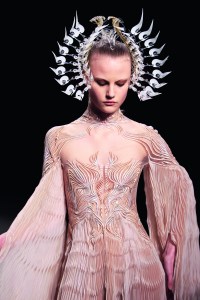
A dress from Iris Van Herpen’s spring 2021 couture film.
Gio_Staiano
Those showcases attracted celebrities who have further fanned her fame and the couture clients that bring the majority of revenues to her Amsterdam-based house.
“I interact with them quite a lot and I really like the personal part of couture. Clients usually come to the atelier, sometimes even a few times,” she says. “We do the fittings, which is a very personal process.…Actually, the exhibition was realized with the help of some clients.”
Van Herpen says that most of her clients are also art collectors, “which I think is really interesting. They see fashion or couture as a form of art. So they will have an art collection also. And I think that’s really beautiful that those two worlds can live together.”
While nature in the broadest sense has long inspired van Herpen — but think about mushrooms and root systems rather than flowers — an invitation to visit Arts at CERN many years ago opened her mind to scientific inspiration.
CERN — an acronym for The European Organization for Nuclear Research — operates the largest particle physics laboratory in the world near Geneva, and van Herpen has visited many times, interacting with some of the thousands of scientists who work there. “I realized I could really take science as inspiration for my collections, and even for my material developments,” she says. “That really became part of my process.…Biomimicry has been a very important influence from the beginning up until now.
“It’s the moment that defines the inspiration in the end, but it can come from many different fields. It can be philosophy, it can be a book, it can be a conversation that I’ve had with someone,” she says.
Or it could be the countryside.
“A while ago I moved outside of the city. So that’s a whole new exploration for me. OK, having a garden and being more in touch with nature even more than before, which I think has a very positive influence on my work.”
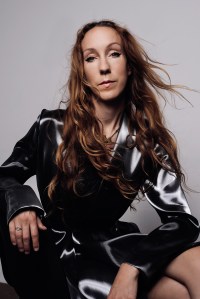
Courtesy of Iris van Herpen/Robin de Puy

